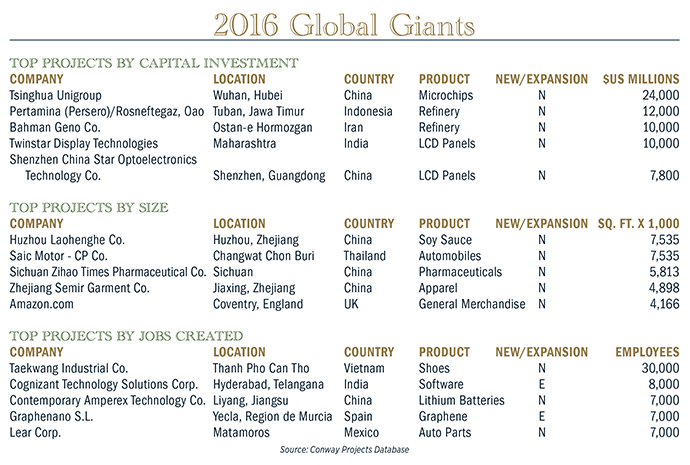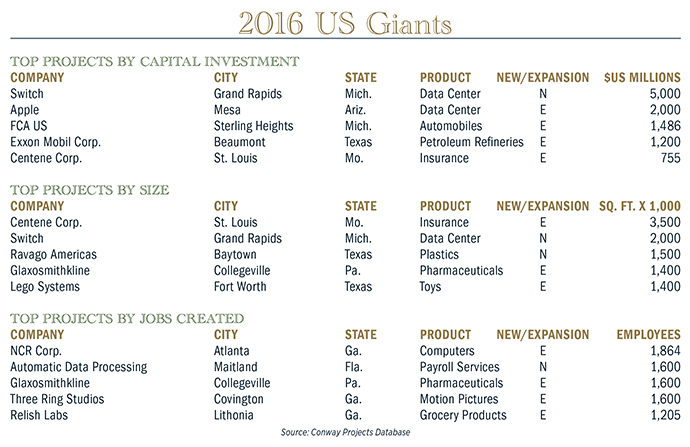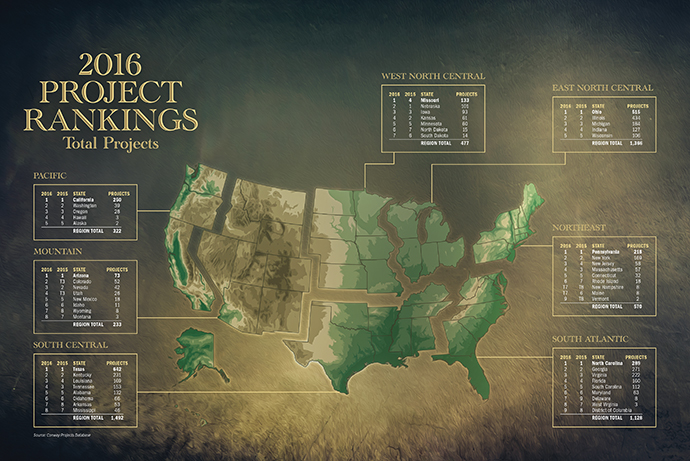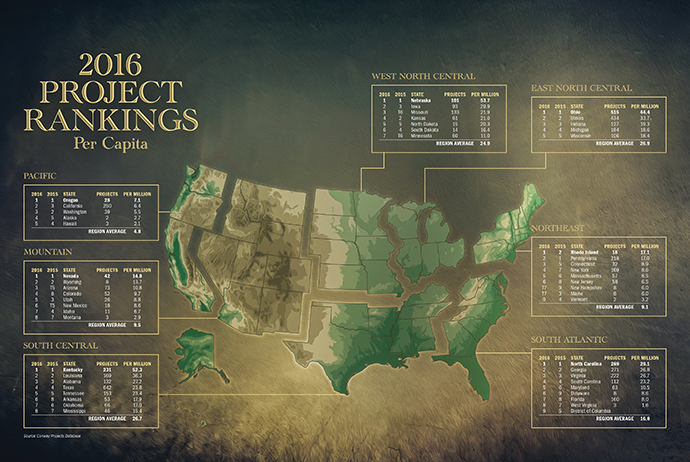Nebraska Gov. Pete Ricketts joins the elite club of US governors to claim a Site Selection Governor’s Cup, by virtue of his state winning the Cup for most capital investment projects per capita — 101 such projects for 2016. Which is not to say it’s Nebraska’s first Cup. It won the first Governor’s Cup for projects per capita, awarded in March 2014, for the Cornhusker State’s 2013 economic development success, which resulted in 109 projects that year. Kentucky won the Cup the next two years and places second in 2016, with 227 projects. That’s more than twice Nebraska’s number of projects, but it’s a per capita contest. Rounding out the top five are Ohio (515), Louisiana (169) and Illinois (434).
Texas Gov. Greg Abbott claims his third Governor’s Cup for total qualified projects — 642 — in 2016, and the Lone Star State’s fifth consecutive such Cup. Texas’ winning streak began when it wrested first place from Ohio in 2009. Including for its 515 projects in 2016, the Buckeye State has placed second in total projects ever since. Rounding out the top five in this category are Illinois, North Carolina (289) and Georgia (271).
The Governor’s Cups reflect yearly project totals as tracked by the Conway Projects Database. Qualifying projects must meet one or more of these criteria for inclusion in the database: a minimum capital investment of $1 million, 20 or more new jobs created, and 20,000 or more square feet of new space.
All Cylinders Running
When Site Selection recognized Gov. Abbott and his economic development team in March 2016 for his state’s success in 2015, a Texas signature industry — energy — was down a quart. It’s a good thing the state has more than one, the governor tells Site Selection.
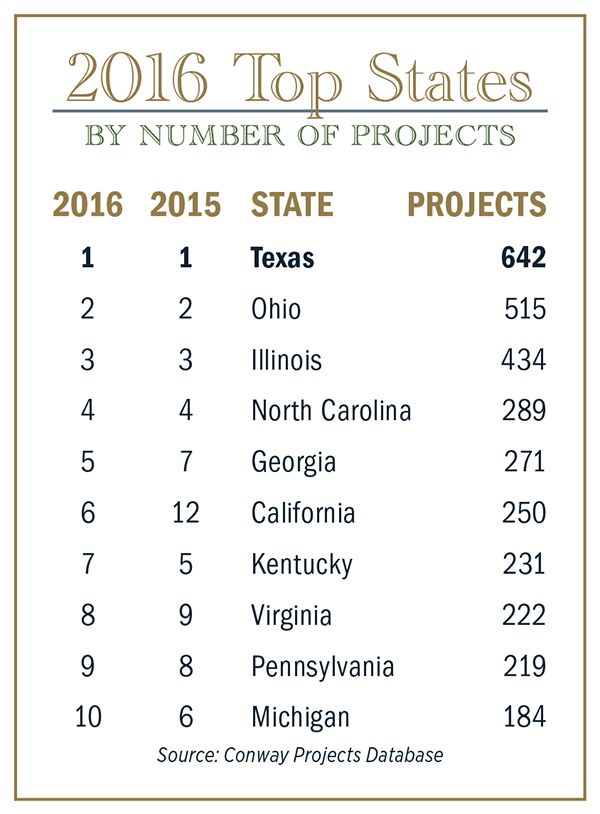
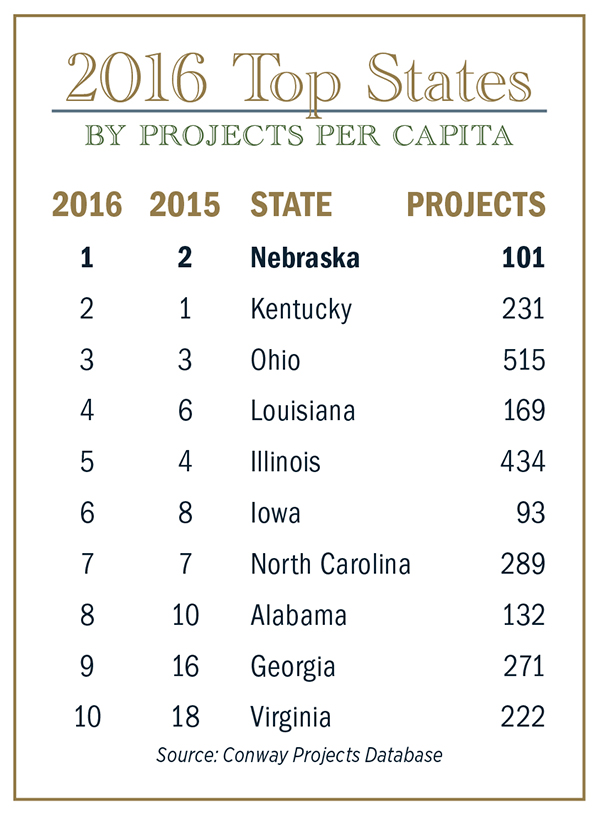
“The Texas economy is very resilient, and that is evident from what has happened this past year,” he relates. “It was about a year ago when oil hit bottom. Despite that, Texas still added well over 200,000 new jobs this last year, and we have more Texans with jobs today than ever before in our state’s history. The reason is we have continued to diversify our economy in areas and sectors that have nothing to do with energy. The high-tech sector is in high growth in Texas, and our healthcare sector and innovation in life sciences are growing very rapidly. These are areas that because they are sectors of the American economy that are growing so rapidly will continue to spur our economy.”
Gov. Abbott points to healthcare and IT giant McKesson Corporation’s March 2016 announcement that it is consolidating and expanding operations in Irving, in the Dallas-Fort Worth Metroplex, as a prime example of this. McKesson’s $157-million expansion is projected to create at least 975 new jobs.

“This expansion is yet another testament to the power of Texas’ low-tax, low-regulation economic climate that continues to attract industry leaders, innovators, and job creators from around the globe,” noted the governor at the time of the announcement. “I am confident McKesson’s leadership in the pharmaceutical and healthcare technology sectors will serve as an invaluable contribution to the Texas economy.”
Not that it needs one, but financial services is fast becoming a Texas secret weapon where capital investment is concerned, whether the energy sector is doing well or not. In August 2016, Charles Schwab Corp. unveiled plans to invest $100 million in a new, regional campus on 70 acres in Westlake, also in the Metroplex, that will include more than 500,000 sq. ft. of commercial space. At least 1,200 new jobs will be housed at the complex over the next 10 years.
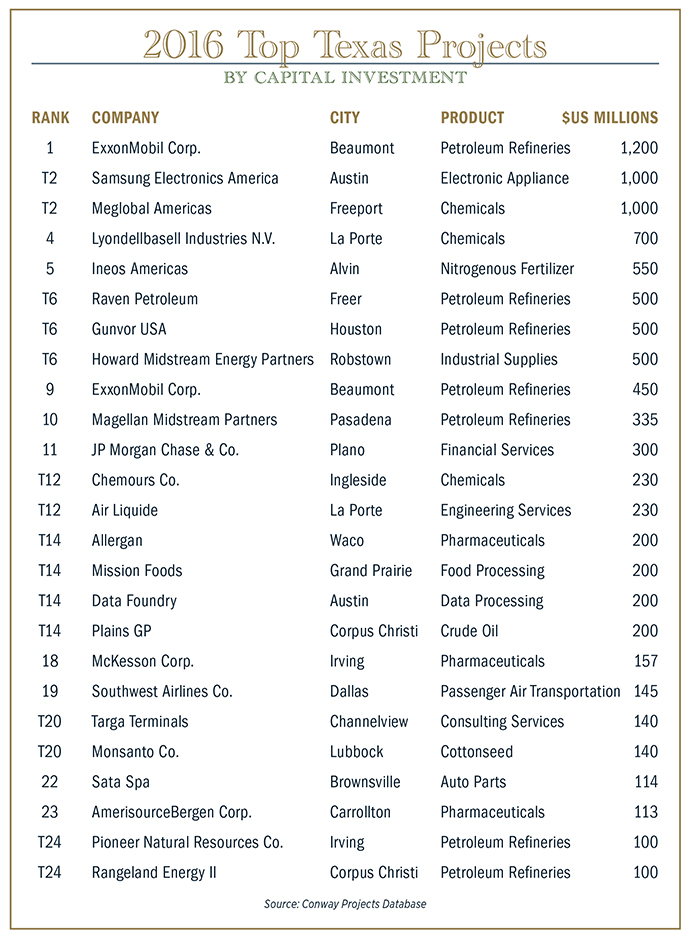
“We’re excited to have this opportunity to expand our presence in Texas, and we’ll be ramping up our recruiting efforts from among the great wealth of employee talent in and around Westlake,” said Schwab Executive Vice President Dennis Howard at the project announcement. “Like Austin, where we already have approximately 1,500 employees, and El Paso where we are building our presence, the Dallas-Fort Worth area is an important location for Schwab to better serve our clients. We look forward to significantly expanding our footprint there over the coming years.”
Schwab will join State Farm Insurance, Fidelity Investments, Liberty Mutual and dozens of other insurance and financial services companies with significant Metroplex and Texas operations. By one measure, about 10 percent of jobs in the Dallas region are in financial services.
On the Legislative Docket
While the governor and the state’s economic development apparatus were welcoming McKesson, Schwab and hundreds of other companies to Texas, he was showing the door to some factors that had overstayed their welcome: “We cut taxes, particularly the business franchise tax, 25 percent,” he explains. “Even though Texas has no corporate income tax, the cost of doing business in Texas decreased even more because of that. Also, we have methodically continued to reduce regulations in Texas, making the business climate even more favorable. We also cut occupational license fees, making it easier for 600,000 Texans to start a job or a business or grow a business.”
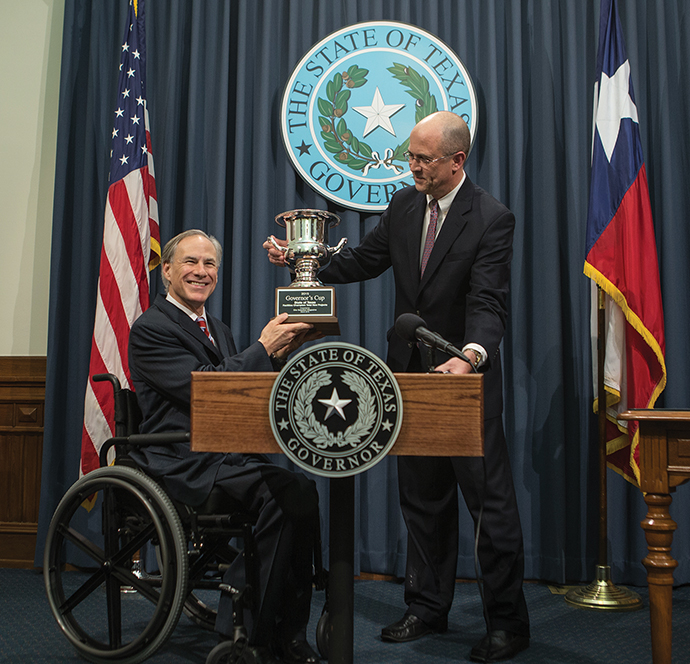
Part of Abbott’s legislative agenda for the 2017 session is to get rid of the business franchise tax altogether. “I want to continue the reduction of that tax and move toward its elimination. There are bills filed now and bills that will be filed in this session in which I will be pushing that tax reduction.”
The heavy lifting on tax reduction will involve lowering Texas’ high property taxes, which in large pay for state and local services in the absence of a state income tax. Forbes recently ranked Texas the fifth best state in the US for taxes, which is enviable. But families relocating to Texas will soon learn to budget more for property taxes than they used to — fly in the business climate ointment that has not gone unnoticed by the governor.
“Property tax is a hot topic in Texas,” Gov. Abbott tells Site Selection. “One of my focal points this session is to pass laws that put strategies in place to cap and reduce property taxes. You can expect property tax reform legislation coming out of this session that will end at the end of May. We want to make sure our property taxes will not be a burden on Texans, and we have strategies to reduce the impact of property taxes on their wallets.” Chances for passage in the legislature? “Our constituents are in agreement [that it has to be done], and my feeling about lawmakers is that an overwhelming majority of them support containing property taxes in Texas and that we will take action this session to get control of that.”
The governor says his discussions with CEOs already in Texas or considering a Lone Star location for future operations don’t involve that — at least in the context of companies’ chief reasons for establishing or growing operations there.
“I ask them, ‘Why Texas?’ Almost to a person they say the key reason is the quality of our workforce,” says Abbott. “That’s something we’ve spent a lot of time and effort improving.”
In September, Gov. Abbott announced the launch of the Texas Industry Cluster Innovative Academies as part of his Tri-Agency Workforce Initiative established in March 2016. The initiative, created to address the governor’s goal of meeting local workforce needs, will provide competitive grant funding to establish Innovative Academies within Texas high schools to provide students with learning opportunities in high demand occupations while earning college course credit prior to high school graduation. The grant program will promote, engage and expand the development of partnerships between regional employers, independent school districts, community colleges, universities, local workforce boards and local industry.
“Preparing the next generation of Texans to enter the workforce is paramount to ensuring that both employees and businesses continue to thrive in the Lone Star State,” said Governor Abbott at the program’s launch. “With these Innovative Academies, Texas will lead the way in forging partnerships across a variety of industries and educational institutions to find the most effective solutions to the challenges we face in the 21st century economy.”
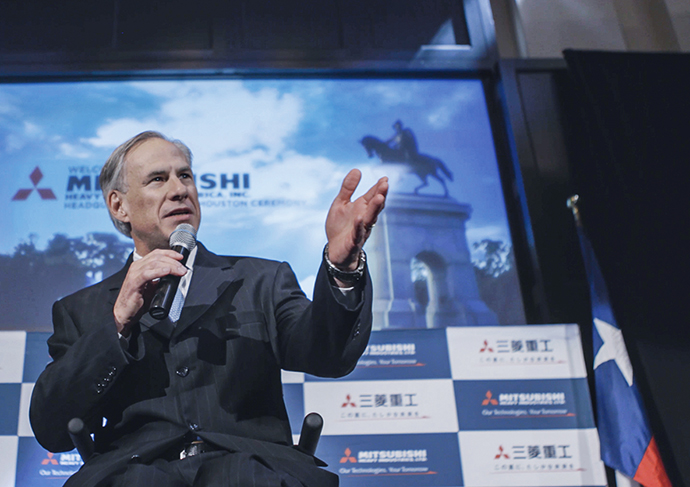
Grants for the Innovative Academies will be used to develop program models that can be replicated or scaled across other campuses or different regions of the state. Each Innovative Academy must serve as a partnership between a public high school, an institution of higher education, and a high-demand industry partner. A combined total of $7.2 million in grants from the Texas Workforce Commission, the Texas Education Agency and the Texas Higher Education Coordinating Board will be offered for the Innovative Academies.
The academies will target specific course work and educational opportunities that lead to direct employment in high-demand occupations for the following industry clusters:
- Advanced Technologies and Manufacturing
- Aerospace and Defense
- Biotechnology and Life Sciences (including Healthcare)
- Energy
- Information and Computer Technology
- Petroleum Refining and Chemical Products
Restocking the Pond
Right up there on the governor’s to-do list with capping or lowering property taxes this legislative session is securing funding for incentives. Specifically, Abbott is seeking $108 million for extending the Texas Enterprise Fund (TEF) and $40 million for Governor’s University Research Initiative. A TEF grant offer of $9.75 million was extended to McKesson Corporation, and one of $6 million was extended to Charles Schwab. The latter will create the largest number of new jobs by a TEF grant recipient since the beginning of Governor Abbott’s administration.
“These funds have proven to be so successful,” Abbott stresses. “Importantly, we have reformed the way these [incentives] funds operate, so there is greater transparency, greater accountability, and they are used solely as deal-closing funds. We don’t believe in using funds like these to pick between winners and losers, and we eliminated some programs that do that. We want the companies for whom these funds are meant to make Texas the winner and other states the loser. To do that, we need to have the Enterprise Fund so we can have a deal closing fund to attract more job creators to Texas.”
Is securing all $108 million feasible?
“It’s deserving,” Abbott asserts. “We’re dealing with a tight budget, and we’ve proven we can live within tight budgets. But I think everybody in Texas agrees that one way that we can best stimulate our economy and grow more jobs is by funding the Enterprise Fund.”
The Governors University Research Initiative is about adding stars to Texas’ higher education and research institution firmament.
“We are bringing in the best and brightest minds in the country in science, technology, engineering, math and medicine,” says the governor. “We lured away one of the premier engineering researchers from Princeton to Texas A&M who will be working on the next generation of aerospace engineering technology in a way that dovetails with national security. Nine have been brought in so far. The point is simple: research and intellectual capital is finding a new home in Texas. Texas for a century now has been the home of energy. Going forward, we are very swiftly becoming the home of innovation. This is something the entire state of Texas is committed to, and we will be leading in the sectors going forward that will attract the next generation of jobs.”
Meanwhile, in Washington
In which state will new policy concerning cross-border trade with Mexico — NAFTA or otherwise — have a greater impact than in Texas? None. A shift to bilateral trade agreements from TPP-style multilateral trade pacts is just one example of changes taking shape on the horizon under a new administration in Washington.
Governor Abbott’s take: “There are two main stimuli related to what’s happening in Washington that will be very beneficial to the Texas economy. One of the hamstrings imposed by the prior administration was heavy-handed regulation that limited the energy sector. It has been declared that those regulations will be reduced, and that should stimulate our energy sector even more. It’s not just production of oil and gas, but the innovation being used that is improving our economy. We are looking to increase the export of oil and gas. I’ve had in my office leaders of countries around the globe who want to get in line to be on the receiving end of LNG that will be exported from Texas. The state is putting LNG export facilities online beginning this year and next year that will be a boon to our economy and support the price of natural gas and will strengthen our coffers even more.

“Regarding the border,” he adds, “Texas has great trade with Mexico, which is good for the economy of Texas, the United States and Mexico. If you understand what the president has talked about, he has an overarching goal, which is to create more jobs and to have fair trade. I believe if you look at his ultimate goal, if policies were implemented that would be bad for trade and hurt jobs, he wouldn’t do it, because that would cause him to fail in his goal. When you get down to the push points of the deals that will be done, they will be deals that are good for trade and good for jobs in Texas and the United States.”
Should NAFTA be reworked?
“NAFTA has been in existence for a long time, so it’s always good to go back and refresh it and refine it,” says the governor. “There are always ways to make it better. Like the president said, he wants to add another F to NAFTA, which is not just free trade but fair trade. We can improve on NAFTA in ways that will be beneficial to Texas and the US on the one hand and Mexico on the other.”

Now that Nebraska has reclaimed the Governor’s Cup for projects per capita, Gov. Pete Ricketts won’t relinquish it easily. And he has several plans for winning it again in the future. One is to leverage his state’s leading industry — agriculture — into an industry of the future rather than take it for granted. Another is to make Nebraska a low-cost state in which to do business, and one where it is easy to do so. Ag revenues are down, he acknowledges, but that’s no reason to delay taking steps to make Nebraska the go-to location in the Heartland for companies in any sector.
Tax relief is the governor’s chief priority in early 2017.
“My goal is to do tax relief every year I’m governor,” Ricketts tells Site Selection. “Two years ago, we increased the property tax credit relief fund by over 45 percent, because we were able to control spending. Last year we came back with 200 bills with regard to property tax relief, largely around expense control. We got some of that, and some went to the property tax relief fund.
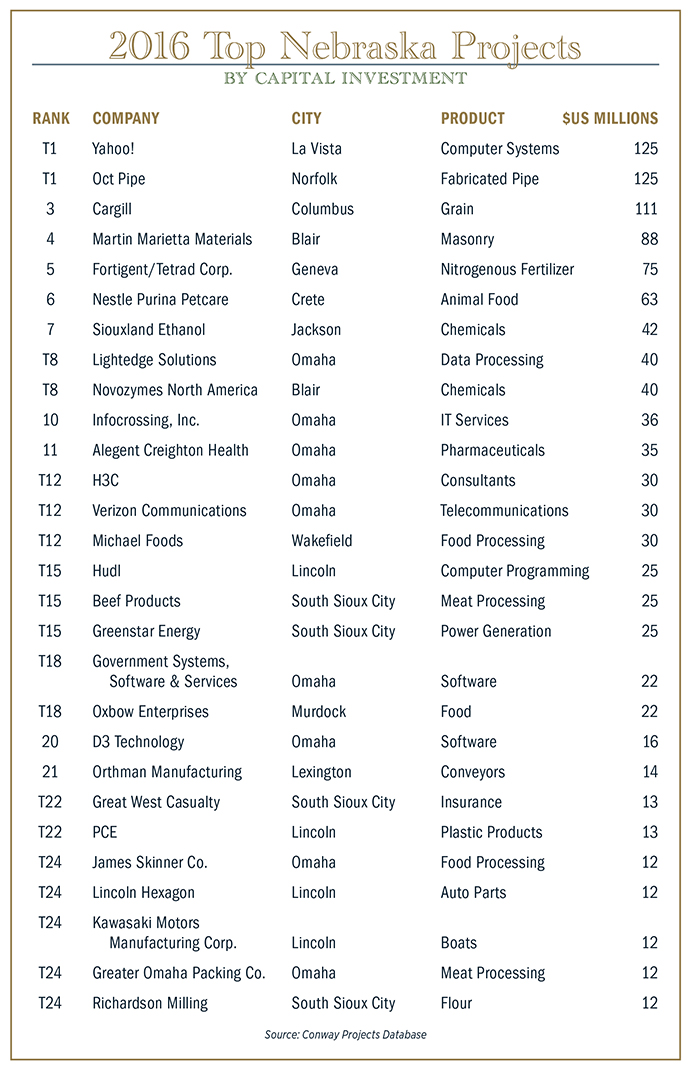
“This year we’re coming back with two bills,” he continues, “one that is fundamentally changing how we view ag land for property tax purposes. It’s changing from the current market sales assessment we do today to an income potential assessment that will link that property tax valuation more closely to what the income potential of the land is. It will be more fair to our farmers and ranchers and more standard across agricultural states. South Dakota went to this a few years ago, North Dakota is using it, Iowa, Illinois, Wisconsin and Ohio. They all use this as a way to help their farms and ranches be more competitive in the marketplace. It’s a major structural change for us; we’re planning to implement it in January 2019 in the bill.”
A More Level Playing Field
The other bill the governor is championing is about income tax relief, specifically taking Nebraska’s top rate of 6.84 percent down about a 10th of a percent at a time over a period of eight years, starting in 2020 to get to 5.99 percent, which will make it more competitive with other states.

“The rate will come down automatically every year we have a forecast of revenue growth of 3.5 percent or more,” Ricketts explains. “That trigger is there so we can manage it within the budget. Some states have cut the tax rates but didn’t control spending, so they ended up in budgetary trouble. We’re doing it the other way around. We’re controlling our spending first, and then we’ll take those tax rates down over time as our economy bounces back and revenues start to grow. We’ll still have to have a balanced budget, but this gives us a schedule for taking those tax rates down.”
A key beneficiary will be small businesses, he adds, “because most of them pay on that individual income rate. It will allow them to invest more money back into their businesses. It’s middle class tax relief, because it allows people to keep more of their own money. It’s about being more competitive when we’re talking about companies looking at our state; we don’t want to be left off site selectors’ lists because our tax rate is too high. And we want to be more competitive for small businesses who pay on this rate to be able to invest in their companies.”
The state needs to spend less too, says Gov. Ricketts, while delivering services in a way that will lure businesses to Nebraska and away from competitive locations.
“Before I became governor, we were growing the state budget at 6.5 percent per year, and that’s just not sustainable,” he points out. “We have to get that spending down. In my first budget, we cut spending to 3.6 percent, and with farming revenues down, we have to tighten our belts even further. In the budget I proposed, we’re only growing government at 1.7 percent for the next two years. You can see we are controlling our spending.”
As for the second objective, Ricketts is “focused on doing a better job delivering our services. Every business has to find ways to serve the customer better and bring down costs at the same time or they will go out of business. No one will put the State of Nebraska out of business, but we have to work by the same philosophy. This is a huge culture change for government, because usually bringing costs down means cutting service. I’m saying they’re not mutually exclusive. We can do both — a better job of delivering services while bringing our costs down. That’s what the private sector does.”
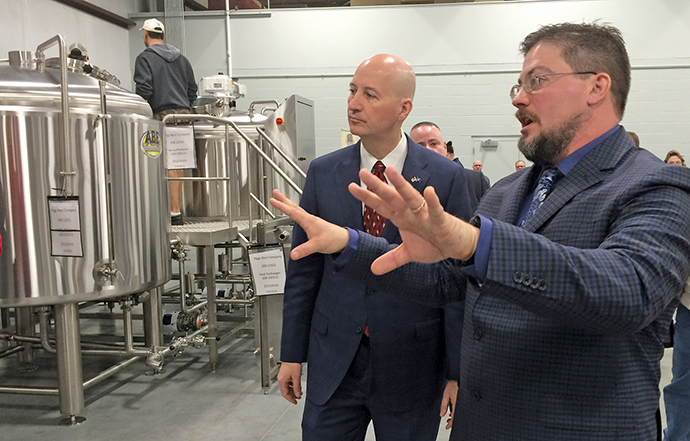
Ricketts is serious about his commitment to making Nebraska a more business-friendly location. “I went to our Department of Environmental Quality to see how long it took them to issue permits,” he illustrates. “They weren’t even measuring it. But by measuring that and posting it online, the time to issue permits started coming down. In one case, it took permitting time down from weeks or months to days. Yahoo was our first customer using this process, and we were able to issue them a permit to expand their data center here in two days. They told me in another state they had already waited eight months and were expecting to wait another eight months. By being more customer-friendly, and putting this process online, we’re providing a higher level of service.”
Much More Than Agriculture
Agriculture still reigns as the leading industry in Nebraska, but it’s also a hotbed of high-tech innovation and manufacturing.
“One project that is very significant is our partnership working with Costco and Lincoln Premium Poultry on a chicken processing plant in Fremont,” notes Ricketts. “That’s about a $1.2-billion investment. It will not only create about 1,000 jobs in Fremont. It will also create a network of growers that will help our farmers and ranchers in the neighborhood. A farmer can sign up to contract with Premium Poultry raising chicks, helping them diversify their revenue stream at a time when prices are down. Farm income in general in Nebraska has gone from $7.5 billion in 2012 to about $4.5 billion. With farm income declining 39 percent, we want to find ways for our farmers and ranchers to diversify their revenue stream that results in a huge economic benefit to the state.”
Meanwhile, look for more startups to emerge from the Jeffrey R. Raikes School of Computer Science and Management at the University of Nebraska-Lincoln. HUDL, a pioneer in the sports software industry, came from there. HUDL is partnering with Nelnet on a video analysis venture and is building a new building in the Haymarket district in Lincoln.
“It will be a work environment people are looking for — something that looks like Silicon Valley — non-traditional workspaces and so forth,” says Ricketts. ”That’s a great example of how we’re looking at innovation and technology to help create opportunities for our young people. Jeff Raikes, a former executive at Microsoft, sees a huge opportunity for us to be able to apply technology to agriculture and create agribusinesses and biotechnology and other things around how we continue to drive industries. By 2050, there will be 2 billion more people on Earth. Because of the rising standards of living, we will have to double the food supply. That means we will have to have more productivity and more innovation. Applying technology to current practices is one of the ways we can do that — we’re already doing that with regard to agriculture, but also with biotechnology and other research going on in the state, like hybrids that will be more productive and how to use less water when growing corn. Those apply to our lead industry here, but will help grow the state as well.”
